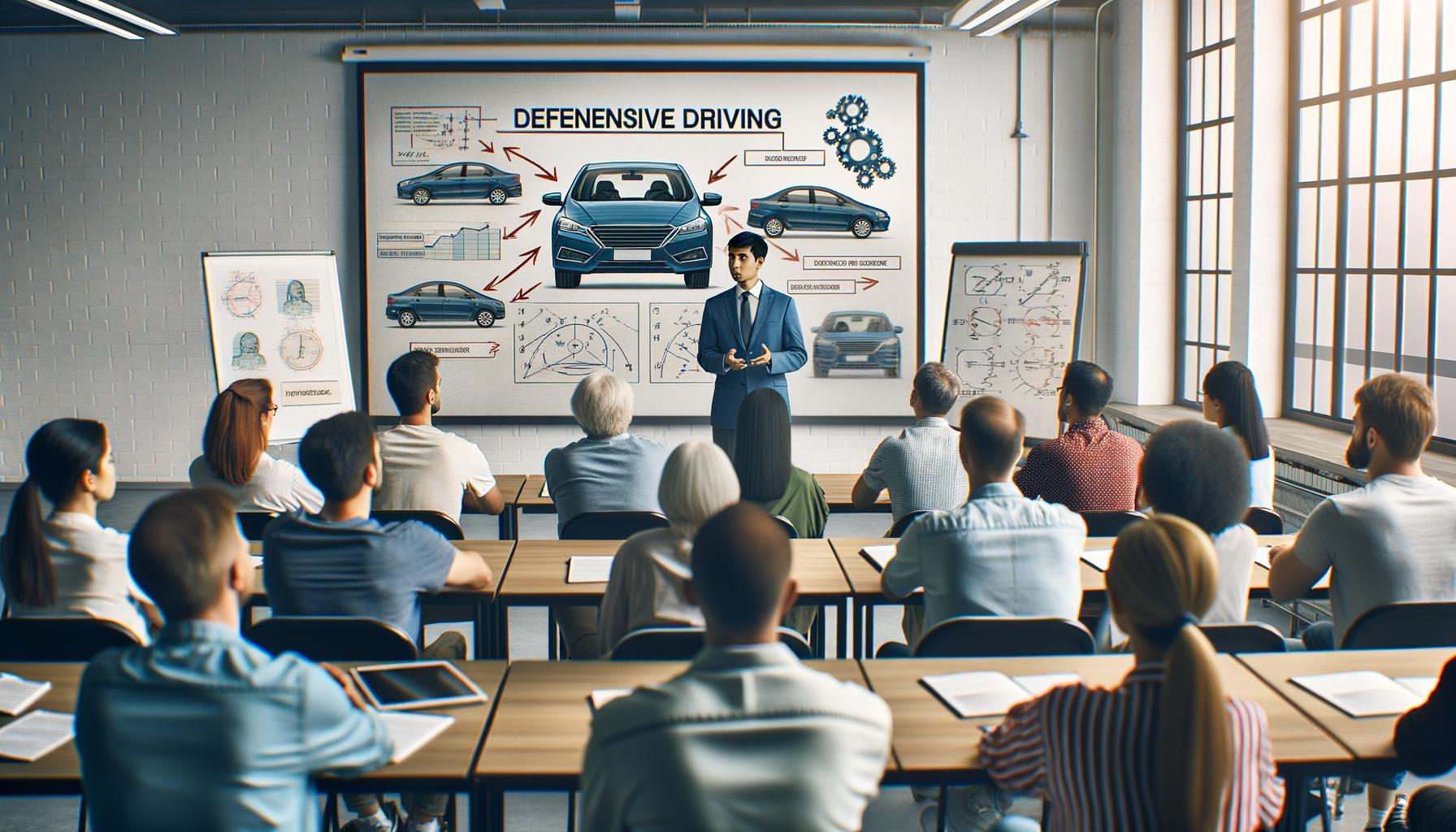What Is a Driver Diagram in Education?
At The Wiser Driver Driving School, we’re always looking for ways to improve education. That’s why we’re excited to explore driver diagrams in education, a powerful tool for visualizing and planning educational improvements.
Driver diagrams help educators identify key factors that influence desired outcomes and develop targeted strategies for success. In this post, we’ll break down what driver diagrams are, how to create them, and why they’re valuable for educational settings.
What Are Driver Diagrams in Education?
Definition and Purpose
Driver diagrams help map out ideas in order to create a theory about how to make changes that will result in an improvement. They visually represent the factors that contribute to achieving specific goals in educational settings. This visual representation allows educators to see the big picture while focusing on actionable steps.

For instance, if a school aims to improve student reading scores, a driver diagram would outline the main factors (or “drivers”) that influence reading performance. These might include teacher training, curriculum design, and parental involvement. Each of these primary drivers would then split into more specific secondary drivers and change ideas.
Evolution in Education
Driver diagrams originated in the healthcare sector as a quality improvement tool. Educators quickly recognized their potential for school improvement, with the Institute for Healthcare Improvement (IHI) playing a significant role in adapting this tool for educational use.
In recent years, schools across the United States have increasingly adopted driver diagrams.
Key Components
A typical driver diagram in education consists of four main elements:
-
Aim Statement: This overarching goal should be specific, measurable, and time-bound.
-
Primary Drivers: These main factors (usually 3-5) directly contribute to achieving the aim.
-
Secondary Drivers: These more specific components influence the primary drivers.
-
Change Ideas: These concrete, actionable steps can be implemented to affect the secondary drivers.
Applications in Educational Settings
Driver diagrams find applications in various educational contexts. Schools use them to improve academic performance, enhance student engagement, and streamline administrative processes. Universities employ these diagrams to refine curriculum development and boost research output.
In driver education, these diagrams help instructors identify key factors that contribute to safe driving practices. They can map out strategies to improve student learning outcomes, enhance practical skills, and increase overall road safety awareness.
Benefits of Using Driver Diagrams
The use of driver diagrams in education offers several advantages:
-
Clarity: They provide a clear visual representation of complex improvement strategies.
-
Focus: They help teams prioritize efforts and resources on the most impactful areas.
-
Collaboration: They facilitate team discussions and consensus-building.
-
Flexibility: As living documents, they can be updated as new insights emerge.
-
Accountability: They make it easier to track progress towards specific goals.
As we move forward, we’ll explore how to create an effective driver diagram, providing you with practical tips to implement this powerful tool in your educational setting.
How to Create an Effective Driver Diagram
Define a Clear Aim
The foundation of any driver diagram is a well-defined aim. This should be specific, measurable, and time-bound. For example, “Increase student pass rates for the state driving test within the next 12 months.” Try to avoid vague goals like “improve driving skills.” The more precise your aim, the easier it becomes to identify the drivers that will help you achieve it.
Identify Primary Drivers
Primary drivers are the main factors that directly contribute to your aim. These should be broad categories that encompass multiple aspects of your goal. In a driving school context, primary drivers might include “Enhance classroom instruction,” “Improve behind-the-wheel training,” and “Increase student engagement.” Limit yourself to 3-5 primary drivers to maintain focus and clarity.
Develop Secondary Drivers
For each primary driver, brainstorm secondary drivers – more specific components that influence the primary drivers. For “Enhance classroom instruction,” secondary drivers could include “Update curriculum materials” and “Implement interactive learning techniques.”
Generate Change Ideas
Next, create change ideas for each secondary driver. These are concrete, actionable steps. For “Update curriculum materials,” change ideas might be “Incorporate recent traffic law changes into lesson plans” or “Create video demonstrations of complex driving maneuvers.”
Visualize and Organize
The visual aspect of a driver diagram is essential for its effectiveness. Use a simple, clear layout with the aim on the left and drivers branching out to the right. Color-coding can help distinguish between levels of drivers and change ideas. Digital tools (like Lucidchart or Microsoft Visio) can be helpful, but even a well-organized whiteboard sketch can suffice.

A driver diagram is a living document. As you implement changes and gather data, you should adjust your diagram. Regular reviews and updates will ensure your improvement efforts stay on track and aligned with your educational goals.
In the next section, we’ll explore how to implement driver diagrams in various educational settings, including driving schools, and discuss real-world examples of their successful application.
Putting Driver Diagrams into Action
Collaborative Creation Process
Driver diagrams work best when created through team efforts. Key stakeholders – teachers, administrators, and students – should contribute their insights. This diversity of perspectives ensures a comprehensive view of challenges and potential solutions.

For example, when a school develops a driver diagram to improve student engagement in driver education courses, it should involve instructors, students, and parents. Each group brings unique insights: instructors might highlight curriculum areas that typically lose student interest, while students could identify engagement barriers they’ve experienced.
Integration with Existing Tools
Schools should not use driver diagrams in isolation. They work best when integrated with other educational planning tools. For instance, schools can pair their driver diagram with a SWOT analysis to identify strengths and weaknesses in their current approach. Alternatively, they can use it alongside a Gantt chart to timeline improvement initiatives.
Real-World Success Stories
Let’s examine some concrete examples of driver diagram implementation in educational settings:
-
A high school used a driver diagram to improve AP exam scores. Their primary drivers included teacher training, student support systems, and curriculum alignment. In the class of 2022, 21.6% of U.S. public high school graduates scored a 3 or higher on at least one AP Exam, up from 18.2% in previous years.
-
A university employed a driver diagram to improve freshman retention rates. They focused on enhancing orientation programs, providing early academic interventions, and fostering social connections. A study investigated how orientation programs predict student retention in distance learning at the University of Cape Coast.
-
In the realm of driver education, a school utilized a driver diagram to reduce student anxiety during behind-the-wheel training. They identified key drivers such as incremental skill building, positive reinforcement techniques, and simulated high-stress scenarios.
Continuous Improvement
The key to successful implementation lies in regular review and adjustment of the driver diagram. As schools gather data and insights, they should refine their approach. This iterative process ensures improvement efforts stay relevant and effective over time.
Measuring Success
Schools should establish clear metrics to measure the success of their driver diagram implementation. These metrics (aligned with the diagram’s aim) help track progress and identify areas for further improvement. For example, a driving school might track student pass rates, instructor evaluations, or student satisfaction scores to gauge the effectiveness of their improvement efforts.
Final Thoughts
Driver diagrams have revolutionized education by providing a structured approach to visualize and implement improvement strategies. These diagrams break down complex goals into manageable components, offering clarity and focus for educators at all levels. From classroom instruction enhancement to overall school performance improvement, driver diagrams in education have consistently demonstrated their value.

The incorporation of driver diagrams into educational practice fosters collaboration among stakeholders and promotes data-driven decision-making. Schools can track progress and adjust strategies as needed, empowering educators to address challenges proactively and achieve meaningful outcomes. Driver diagrams apply across various educational settings, including driver education, helping to refine approaches and provide the best possible instruction.
We at The Wiser Driver encourage all educators to explore the potential of driver diagrams in their own practice. This versatile tool can guide efforts to improve student engagement, boost academic performance, or enhance specific skills like safe driving. The journey of educational improvement continues, and driver diagrams serve as a roadmap to navigate the complexities of teaching and learning.
















































